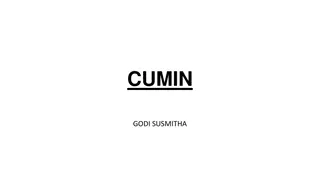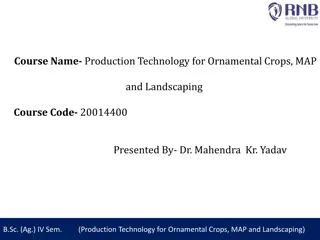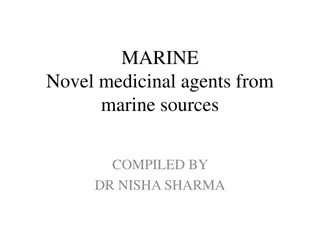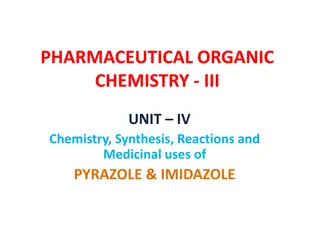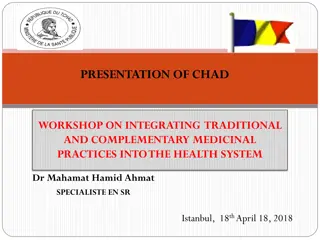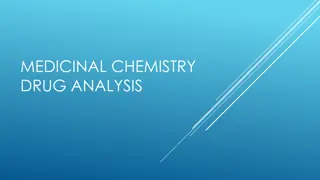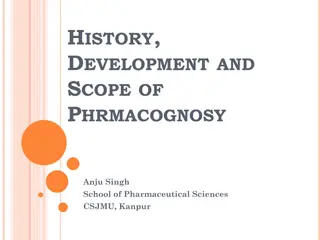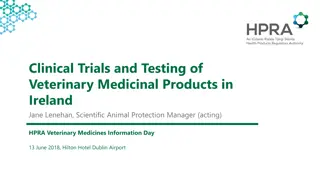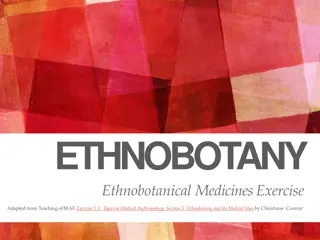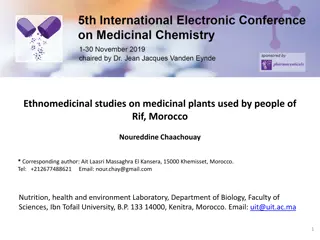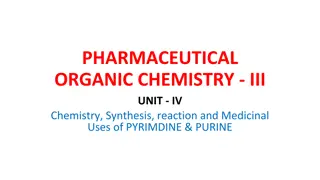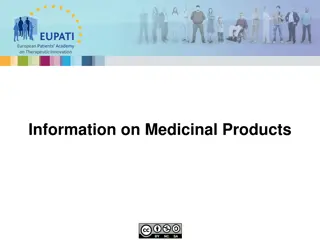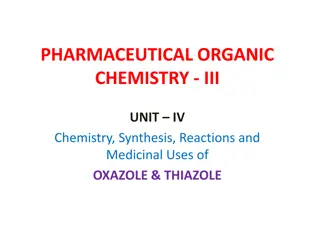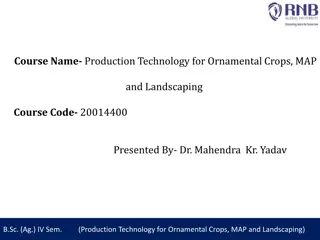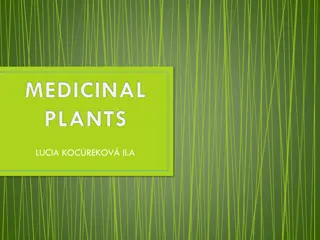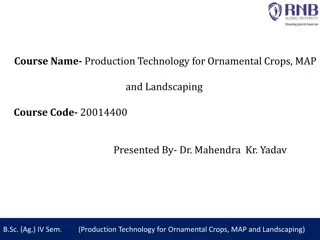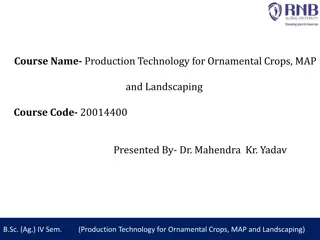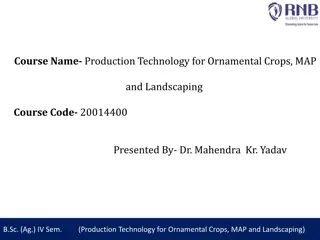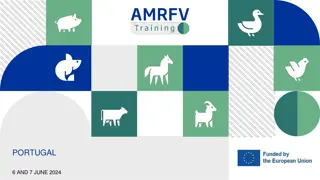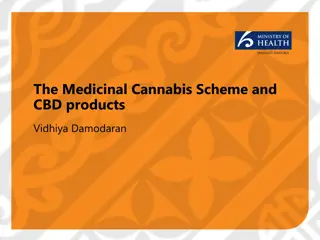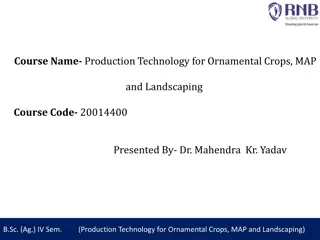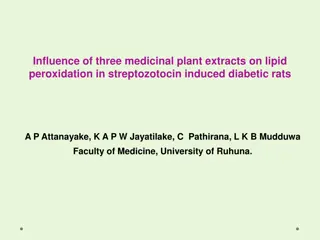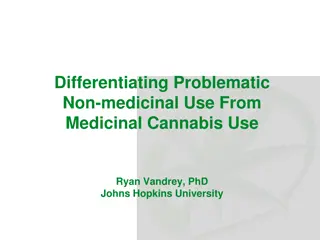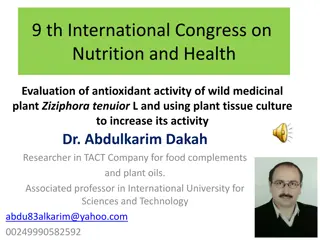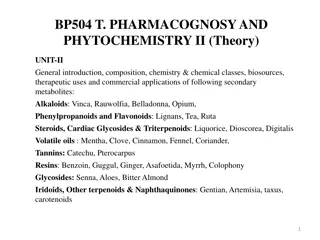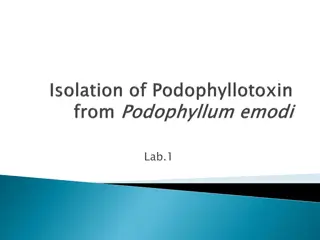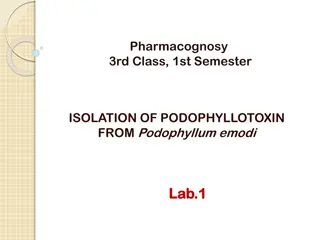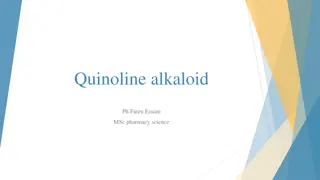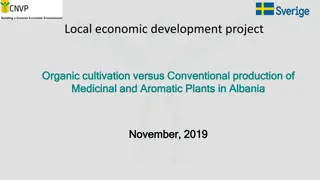Understanding Tannins: Properties, Classification, and Medicinal Uses
Tannins are secondary metabolite products with astringent properties, high molecular weight, and various solubility and taste characteristics. They can be classified into true tannins and pseudo-tannins based on the Goldbeater skin test, as well as hydrolysable and condensed tannins based on chemica
6 views • 13 slides
Understanding Anthraquinone Glycosides: Pharmacognosy Insights
Anthraquinone glycosides are compounds found in medicinal plants like Senna, Cascara, and Aloe, known for their therapeutic actions. These glycosides are hydrolyzed to yield active aglycones, which act as stimulant cathartics by increasing smooth muscle tone in the colon. Market formulations and ext
1 views • 11 slides
Cumin: A Versatile Spice with Rich History and Uses
Cumin, scientifically known as Cuminum cyminum L., is a widely used spice with a rich history and versatile culinary and medicinal uses. Originating from Egypt and widely cultivated in countries like India, cumin seeds are known for their aromatic flavor and are essential in various cuisines worldwi
0 views • 11 slides
Production Technology for Ornamental Crops and Landscaping Course Overview
This course provides a comprehensive study on the production technology for ornamental crops, medicinal plants, and landscaping practices. Topics include identification of different crops, landscaping principles, package of practices for flowers, processing techniques, and more. Students will learn
1 views • 14 slides
Sources of Drugs and Their Origins
Drugs can be sourced from six major categories: plants, animals, minerals/earth, microbiological sources, semi-synthetic sources, synthetic sources, and recombinant DNA technology. Plant sources, being the oldest, provide various medicinal properties through leaves, flowers, fruits, seeds, roots, ba
0 views • 11 slides
Understanding Thermal Power Plants: Overview and Operation
Thermal power plants play a crucial role in converting heat energy into electricity for various applications. This article covers the definition, layout, working principle, and components of thermal power plants, highlighting their advantages and top features. From converting heat into mechanical po
0 views • 20 slides
Marine Novel Medicinal Agents from Marine Sources Compiled by Dr. Nisha Sharma
Oceans, covering more than 70% of the Earth's surface, harbor a plethora of invertebrates and algal species, providing a rich source of medicinal compounds. Marine organisms have yielded commonly used drugs like shark and cod-liver oils, sodium alginate, agar-agar, and chitin. Various classification
1 views • 9 slides
Chemistry and Medicinal Uses of Pyrazole & Imidazole
Explore the chemistry, synthesis, reactions, and medicinal applications of pyrazole and imidazole compounds in pharmaceutical organic chemistry. Dive deeper into the molecular structures and understand the significance of these compounds in drug development and therapy.
1 views • 20 slides
Chemistry, Synthesis, Reactions, and Medicinal Uses of Pyridine & Azepine
Explore the fascinating world of pharmaceutical organic chemistry with a focus on Pyridine and Azepine. Learn about the chemistry, synthesis, reactions, and medicinal applications of these important compounds through a series of informative slides. Delve into the structural characteristics, synthesi
2 views • 23 slides
Chad Workshop on Integrating Traditional and Complementary Medicinal Practices
Chad held a workshop on integrating traditional and complementary medicinal practices into the health system, emphasizing the importance of traditional medicine alongside modern medical care. The presentation highlighted the country's population, reliance on traditional medicine, legal frameworks, a
0 views • 12 slides
Exploring Medicinal Chemistry and Drug Analysis
Medicinal chemistry involves the discovery and development of therapeutic chemicals for medicine, focusing on the interaction of compounds with biological systems. It explores the benefits and drawbacks of drugs, emphasizing the importance of safety and efficacy. Examples such as morphine, barbitura
0 views • 16 slides
History, Development, and Scope of Pharmacognosy
Pharmacognosy is the study of medicinal uses of crude drugs obtained from plants and natural resources. It involves researching physical, chemical, and biological properties of drugs from natural sources. The history of pharmacognosy dates back to prehistoric times, where the use of medicinal plants
0 views • 17 slides
Veterinary Medicinal Products Clinical Trials in Ireland
This presentation covers the process and regulations surrounding clinical trials and testing of veterinary medicinal products in Ireland. Topics include the application process, HPRA evaluation, fees, scope of legislation, and the purpose of clinical trials. Feedback from a 2016 HPRA survey on clini
3 views • 17 slides
Understanding the Medicinal and Toilet Preparations (Excise Duties) Act, 1955
The Medicinal and Toilet Preparations (Excise Duties) Act, 1955 was introduced to standardize excise duties on alcohol-containing medicinal and toilet preparations across India. It aims to regulate the collection of levies, ensure uniformity in duty rates, and address irregularities from previous ac
0 views • 35 slides
Exploring Ethnobotanical Medicinal Practices in Different Cultures
Traditional medical practices in various societies utilize plants, herbs, and fruits for their healing properties. Common examples include garlic and ginger, known for their antiseptic and remedial qualities. This teaching exercise from Yale University delves into the diverse cultural perspectives o
3 views • 14 slides
Ethnomedicinal Studies on Medicinal Plants in Rif, Morocco
This study conducted in the Rif region of Morocco aimed to identify medicinal plants used by local people to treat digestive system disorders. The research documented 87 plant species from 43 families, highlighting the community's reliance on traditional ethnomedicinal knowledge. Results indicated T
2 views • 14 slides
Chemistry, Synthesis, Reactions, and Medicinal Uses of Pyrimidine & Purine
Explore the fascinating world of pharmaceutical organic chemistry in Unit IV, focusing on the chemistry, synthesis, reactions, and medicinal applications of Pyrimidine and Purine compounds. Dive deep into the structures, properties, and pharmacological significance of these essential molecules throu
1 views • 15 slides
European Patients Academy on Therapeutic Innovation: Information on Medicinal Products
Accurate and up-to-date information on medicinal products is crucial for patients and healthcare professionals. The European Patients Academy on Therapeutic Innovation provides insights into topics such as package leaflets, labelling requirements, and information to be provided according to the Dire
0 views • 25 slides
Chemistry, Synthesis, Reactions, and Medicinal Uses of Oxazole & Thiazole
Explore the world of pharmaceutical organic chemistry in Unit IV, delving into the chemistry, synthesis, reactions, and medicinal applications of Oxazole and Thiazole. Gain insights into the structures, synthesis methods, and pharmacological significance of these important compounds through detailed
0 views • 18 slides
Production Technology for Ornamental Crops, MAP, and Landscaping: Cinnamomum Production
This course covers various aspects of ornamental and medicinal crops, landscaping principles, and production technology. It explores the cultivation techniques of important ornamental crops, as well as issues related to medicinal and aromatic plants. Specifically focusing on Cinnamomum, the course d
0 views • 9 slides
Exploring Medicinal Plants in Presov Region: Tussilago and Urtica Dioica
Discover the diverse flora of the Presov region, showcasing a variety of plants like Tussilago and Urtica Dioica. Learn about their habitats, harvesting techniques, and healing effects as valuable medicinal resources in this picturesque natural setting.
2 views • 12 slides
The Fascinating World of Medicinal Plants Through History
Explore the ancient origins and diverse uses of medicinal plants in treating diseases, from prehistoric times to modern societies. Discover how these natural remedies have played a crucial role in healthcare practices worldwide. Learn about the historical records, cultural significance, and scientif
1 views • 43 slides
Production Technology for Ornamental Crops, MAP, and Landscaping Overview
This course covers the production technology for ornamental crops, medicinal and aromatic plants, and landscaping principles. It includes identifying different types of plants, cultivation practices, medicinal uses, and processing techniques. Specific focus is given to the production technology of a
0 views • 10 slides
Production Technology for Ornamental Crops, MAP, and Landscaping with Dr. Mahendra Kr. Yadav
This course on production technology focuses on identifying various ornamental and medicinal crops, exploring landscaping principles, production technology, package of practices for loose flowers, and problems with medicinal plants. It also highlights the importance of processing and value addition
0 views • 16 slides
Production Technology of Costus: Medicinal Herb Cultivation and Uses
Explore the production technology of Saussurea costus, a medicinal herb valued for its tonic, stimulant, and antiseptic properties in Ayurvedic medicine. Discover its uses in traditional Chinese medicine, aphrodisiac qualities, and benefits for various health conditions. Learn about cultivating Cost
0 views • 10 slides
New EU Medicated Feed Regulations Lecture in Portugal, June 2024
Explore important elements of the EU Medicated Feed Regulations in a hands-on training for farmers and veterinarians in Portugal on June 6th and 7th, 2024. Learn about measures to combat antimicrobial resistance, EU legal frameworks on veterinary medicinal products, common rules for veterinary presc
0 views • 17 slides
Overview of Medicinal Cannabis Scheme and CBD Products in New Zealand
The Medicinal Cannabis Scheme in New Zealand aims to improve access to quality medicinal cannabis products for patients by setting up a licensing regime for manufacture and supply. It establishes minimum quality standards to ensure consistency and quality of prescribed products. Access to medicinal
0 views • 10 slides
Asexual Reproduction in Plants: Methods and Examples
Asexual reproduction in plants, also known as vegetative propagation, involves various methods such as tubers, bulbs, and runners. It allows plants to reproduce without the involvement of sex cells and fertilization, resulting in genetically identical offspring. Artificial propagation techniques lik
0 views • 11 slides
Production Technology of Periwinkle - Medicinal Plant Cultivation Guide
Learn about the production technology of periwinkle, a perennial ornamental herb with medicinal properties. Understand its botanical details, uses in treating diseases, cultivation requirements such as soil and climate preferences, and its significance in pharmaceuticals. Discover the various alkalo
0 views • 10 slides
A Closer Look at Plants and Their Importance in Our Ecosystem
Plants play a vital role in our ecosystem, not only through photosynthesis but also in regulating atmospheric gases like oxygen and carbon dioxide. Understanding the definition of plants, from green algae to flowering plants, is essential. By studying plants, we uncover their critical contribution t
0 views • 12 slides
Understanding Plant Classification and Characteristics
Discover the classification of plants based on their structures and characteristics, including vascular vs. nonvascular plants, seed plants vs. seedless plants, and the definitions of angiosperms, gymnosperms, dicots, and monocots. Learn about the history of plant classification and how plants are g
0 views • 27 slides
Influence of Medicinal Plant Extracts on Lipid Peroxidation in Diabetic Rats
Traditional medicinal plant knowledge plays a crucial role in diabetes treatment. Free radicals and oxidative stress are key factors in diabetic complications. This study investigates the effects of three plant extracts on lipid peroxidation in diabetic rats, highlighting the potential benefits of n
0 views • 20 slides
Understanding Problematic vs. Medicinal Cannabis Use
Cannabis presents a unique case of transitioning from illicit to legal status, highlighting the importance of distinguishing between problematic non-medicinal and medicinal use. Despite availability and changing laws, there's a risk of transitioning from medicinal to problematic use, necessitating c
0 views • 18 slides
Understanding the Role of Antioxidants in Health: Insights from Dr. Abdulkarim Dakah's Research
Dr. Abdulkarim Dakah's research focuses on evaluating the antioxidant activity of the wild medicinal plant Ziziphora tenuior and using plant tissue culture to enhance its effectiveness. He discusses Reactive Oxygen Species (ROS), diseases caused by ROS, methods to reduce ROS in the body, and the imp
0 views • 18 slides
Exploration of Tropane Alkaloids: Atropine, Scopolamine, and More
Tropane alkaloids are a diverse group of secondary metabolites found in plants like Atropa belladona and Datura stramonium. Known for their medicinal properties, these alkaloids have notable therapeutic uses and can be chemically classified based on their structures and biosources. Atropine and scop
0 views • 10 slides
Exploring Podophyllum Emodi: Medicinal Properties and Extraction Process
Podophyllum Emodi, also known as Indian Podophyllum, is a plant native to the north Himalayan region. It contains podophyllotoxin, a lignan compound with various medical applications such as treating genital warts and cancer. The extraction process involves isolating podophyllotoxin from the roots a
0 views • 10 slides
Understanding Podophyllotoxin: Isolation, Mechanism of Action, and Medicinal Uses
Learn about the isolation process of podophyllotoxin from Podophyllum emodi, a lignan with potential medicinal applications. Explore its mechanism of action as a tubulin polymerase inhibitor and its uses in treating genital warts and various cancers. The structure of podophyllotoxin and its signific
0 views • 14 slides
Understanding Quinoline Alkaloids in Ruta graveolens for Medicinal Purposes
Ruta graveolens, commonly known as Rue, contains quinoline alkaloids and other active constituents with medicinal properties. This plant is used in the treatment of various inflammatory conditions, ulcers, arthritis, and more. However, there are cautionary notes for specific groups such as pregnant
0 views • 14 slides
Plant Classification and Reproduction Overview
Plants are categorized into four groups: Mosses, Ferns, Conifers, and Flowering Plants. Mosses reproduce by spores and lack roots or xylem vessels. Ferns reproduce via spores, while conifers reproduce with seeds found in cones and have needle-shaped leaves. Flowering plants reproduce using seeds fou
0 views • 8 slides
Comparative Analysis of Organic and Conventional Cultivation of Medicinal and Aromatic Plants in Albania
This report delves into the challenges and advantages of organic and conventional cultivation of Medicinal and Aromatic Plants (MAPs) in Albania. Issues such as price fluctuations, market trends, and quality considerations are explored. Organic markets offer benefits in quality and client satisfacti
0 views • 9 slides


